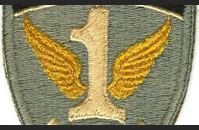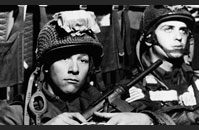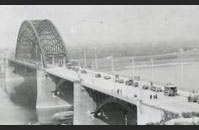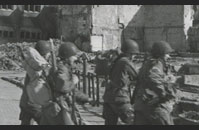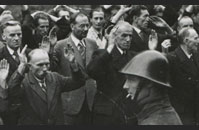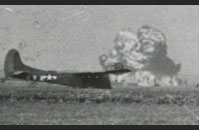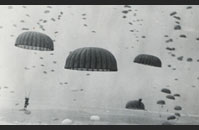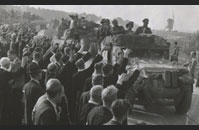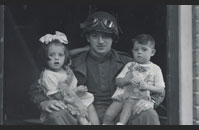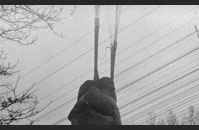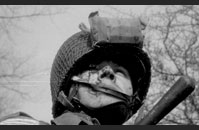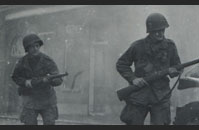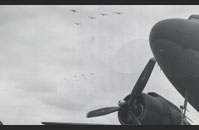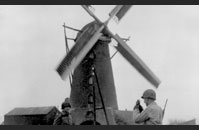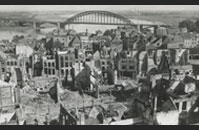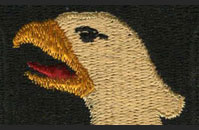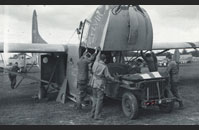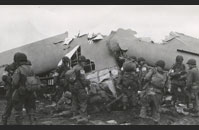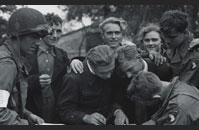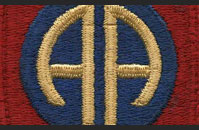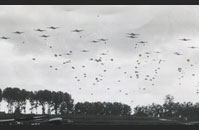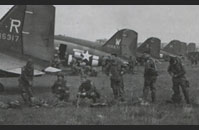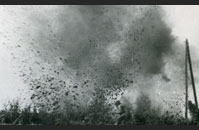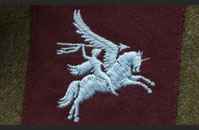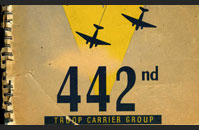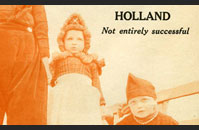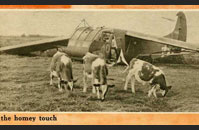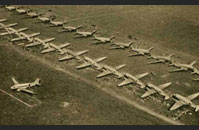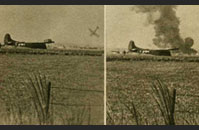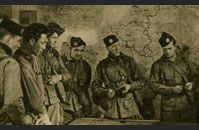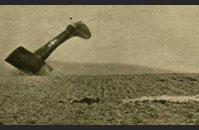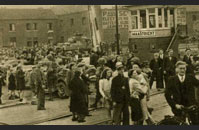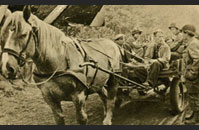FOCUS ON: OPERATION MARKET-GARDEN:
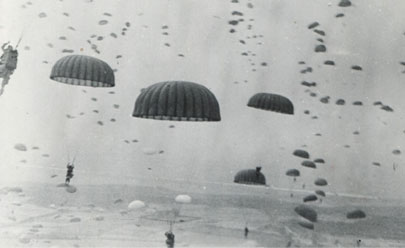
Creation of the First Allied Airborne Army
After several weeks of fighting, the sky soldiers of Normandy were relieved and sent back to England to rest and reorganize for their next assignment. The success of the 82nd and 101st airborne divisions in the Normandy campaign prompted the creation of the First Allied Airborne Army which was activated on 2 August 1944. The new formation put all allied airborne units and troop carrier groups under one unified command. The First Allied Airborne Army was a true multi-national force, containing British, Canadian and Polish units, with the Americans putting up the lion’s share of men and material with three airborne divisions and 9th Troop Carrier Command along with several smaller independent units.
First Allied Airborne Division Patch:
Into Action
Allied commanders feverishly tried to implement battle plans that would utilize First Allied Airborne Army to its fullest potential, which was viewed by Eisenhower’s generals as the equivalent to the queen on the chess board, extremely powerful and able to move anywhere. Several operations were planned but canceled due to the speed of advancing Allied ground forces overrunning the proposed drop zones before First Allied Airborne Army could be deployed. British Field Marshall Bernard Montgomery submitted and received approval for Operation Market-Garden, which would be First Allied Airborne Army’s baptism of fire.
Montgomery’s plan was a two-pronged attack; Market was the code name for the airborne element which called for 34,600 troops to be dropped behind German lines to capture major roadway bridges in the Dutch cities of Eindhoven, Nijmegen and Arnhem. The airborne forces would hold these key bridges until the British armored XXX Corps, code-named Garden, which was traveling overland from the Belgian-Dutch border, would link up with the isolated airborne forces and advance across each strategically captured bridge. XXX Corps timetable to travel the sixty-four miles to Arnhem Bridge was two to three days at the latest. Upon Market Garden’s success the Allies would have outflanked the fixed German fortifications of the Siegfried line and have established a bridgehead across the Rhine. This was not to be the case.
Execution
On 17 September 1944 the airborne element conducted the largest daylight drop of the war up until that point. The pre-invasion bombardment by B-17s of the Eighth Air Force was very effective in reducing German anti-aircraft defenses. The heavy flak that was so instrumental in breaking up the formations of the C-47 troop carriers in the Normandy drop and thereby causing the paratroopers to be scattered to the wind, wasn’t present in Holland. Light flak and daylight benefitted troop carrier command’s navigational accuracy and the airborne infantry and artillery regiments’ assembly time once on the ground.
Images from The National Archives:
101st Airborne Division
The 101st Airborne Division was able to capture two of the three bridges in their area of operation. The bridge at Son over the Wilhelmina Canal, was blown up by the Germans, mere yards from advancing troopers of the 506th PIR. By the time XXX Corps arrived with engineers to bridge the canal, the British advance was already over thirty hours behind schedule. After XXX Corps passed into 82nd Airborne’s area of operation, the troopers of the 101st held the narrow road now being referred to as “Hell’s Highway” open for the supply column that would support the British armored spearhead.
101st Airborne Division Patch & Images:
82nd Airborne Division
Meanwhile, in Nijmegen the 82nd was grappling with German defenders over control of the bridge over the Waal River. German resistance was too great for the lightly armed paratroopers to take the bridge unsupported; the 82nd would have to await the arrival of armor support from XXX Corps. On 20 September, 2nd Battalion 504th PIR and XXX Corps tanks moved into position to assault the south end of the bridge at Nijmegen. Maj. Julian Cook, commanding officer of 3rd Battalion 504th PIR, led his men in a daring daylight river crossing in flimsy, British-made canvas boats, four-hundred yards across the Waal River to assault the northern end of the bridge. Cook’s men were subjected to intense German fire and sustained heavy casualties, but were successful in taking the north end of the bridge as XXX Corps tanks simultaneously took the southern end.
82nd Airborne Division Patch & Images:
British 1st Airborne Division and Polish Airborne Brigade
The British 1st Airborne Division was dropped on the far side of the Rhine River, but due to the lack of suitable drop and landing zones, the Brits were nearly ten miles from their objective of Arnhem bridge. To make matters worse, a large portion of the troops who landed on the first day had to remain on the drop and landing zones to defend them for subsequent drops that would deliver the rest of the division and Polish Brigade. As available British airborne elements moved out towards Arnhem Bridge, units began being ambushed, isolated, and cut off from each other. Only one battalion of troops, led by Lt. Col. John Frost, reached the north end of Arnhem bridge on the evening of 17 September. Several attempts made by Frost’s battalion to capture the southern end of the bridge failed.
Allied intelligence reports prior to the operation led British paratroopers to believe that the German defenders in the Arnhem area were run-of-the-mill. In reality, they had landed right on top of the elite II SS Panzer Corps. The paratroopers were woefully ill-equipped to fight German tanks. To compound British problems further, Frost’s battalion on Arnhem bridge was unable to communicate with the rest of the division due to faulty radio equipment. British 1st Airborne Divisional Headquarters were having great difficulty communicating with England and XXX Corps for the same reason.
As the situation for the British rapidly deteriorated, the Germans counter-attacked. The drop and landing zones that were vital for aerial resupply and reinforcements were overrun by the Germans, leaving the British cut off. In addition, after a gallant three-day struggle, Frost’s battalion surrendered to German forces on Arnhem bridge.
On 21 September the Polish brigade entered the fray after several days of weather delays. With the loss of the British drop zones on the northern bank of the Rhine, the Poles were forced to land on alternate drop zones on its southern bank. An attempt was made by the Poles to reinforce the British, who were now surrounded with their backs against the Rhine on the other side of the river, but failed with disastrous results for the Poles.
On the ninth day of the operation, with XXX Corps just a couple of miles away and the operation’s ultimate objective of capturing the Rhine river bridge at Arnhem no longer obtainable, British 1st Airborne received orders to withdraw. Under the cover of darkness, the remnants of the British forces north of the Rhine were ferried across the river by XXX Corps engineers. Over 10,000 troops had landed in Arnhem on 17 September; nine days later a little over 2,000 escaped to safety. The rest were either killed or captured.
British 1st Airborne Division Patch:
The Aftermath
Operation Market-Garden was a complete failure. After the Germans stopped the Allied offensive at Arnhem, the Allies retreated back to Nijmegen to establish a defensive position. The highly specialized shock troops of the American 82nd and 101st airborne divisions remained under British operational control until November 1944, misspent as conventional infantry in stagnant defensive positions. Arnhem remained in German hands for the war’s entirety. Allied forces would not set foot on the northern bank of the Rhine again until March 1945.
442nd Troop Carrier Group Unit History:
Diary Excerpt of Tech. Sgt. Samuel Millman
8th Air Force, 2nd Air Division, 93rd Bombardment Group, 409th Bombardment Squadron
Monday, 18 September 1944
(Gift of Charles Millman)
Today marked the largest airborne invasion in the history of warfare. A mighty fleet of C-47 transports carrying men and equipment invaded Holland. According to SHAEF [Supreme Headquarters Allied Expeditionary Force] the success of this magnanimous action could possibly shorten the war by many weeks.
Our division of the 8th Air Force, consisting solely of B-24 Libs [Liberators], was given the job of hauling supplies in support of the troops. Our ships, approximately 250, carried K rations and 75mm shells. A goodly amount of ammunition for the bombers’ guns was sacrificed in lieu of extra food and arms.
The 24’s skirted the flak areas as well as possible but ran into plenty of trouble. They went over the target at an altitude of fifty feet and climbed to 400 while releasing their cargo.
The ships flew so low that everything going on on the ground was clearly visible to the bomber crews. Horses and cattle ran stark mad into streams and through fences due to the unaccustomed sight and sound of our bombers.
The flak was very heavy and a number of ships were hit. Two were shot down over the target as the formation headed back for the Channel.
One ship ditched, crash landed in the Channel and three men got out alive. A major, the pilot of this stricken craft, died at the controls.
We learned after the mission that two ships were shot down, but no one knew at the time if they were from our field [Hardwick, England] or squadron. I went to the barracks and learned that one crew that lived in our hut had not returned. I was hoping for their safety, but took for granted that they were the crew of one of the two fallen planes.
We stayed awake chewing the rag until 0100, no one mentioning the missing crew, but hoping against hope that they would come in the door, boisterously or otherwise.
We hit the hay, trying to avoid glances at the empty beds which was impossible to do. I awoke in the middle of the night and looked for the belated crew, but the bunks were still empty. Although I haven’t known these boys very long, I hope to God they come through O.K.

